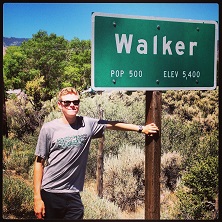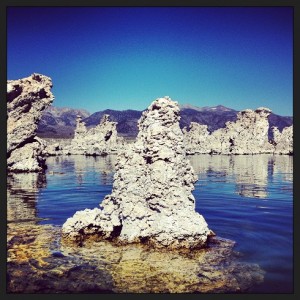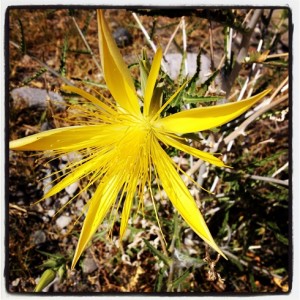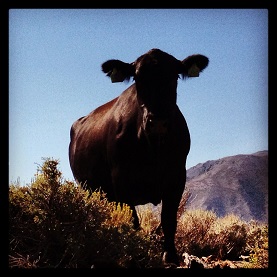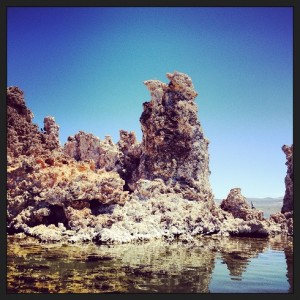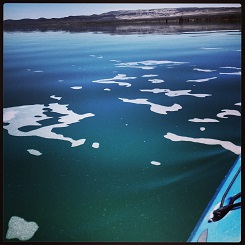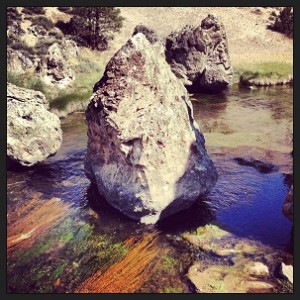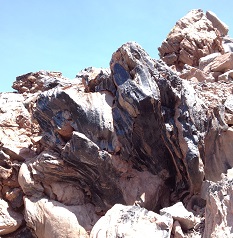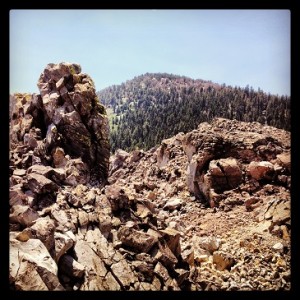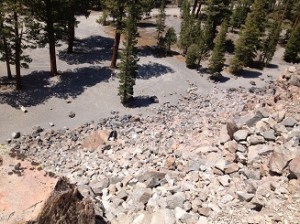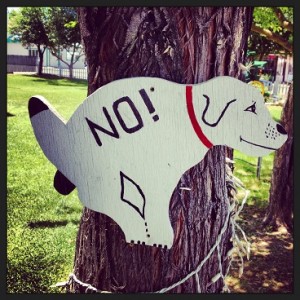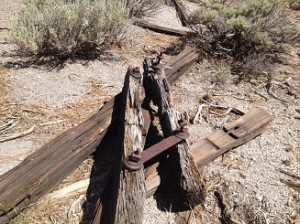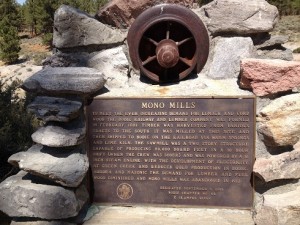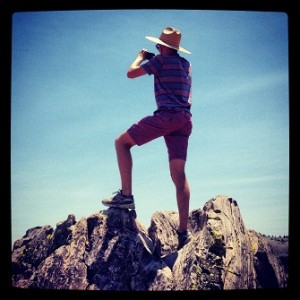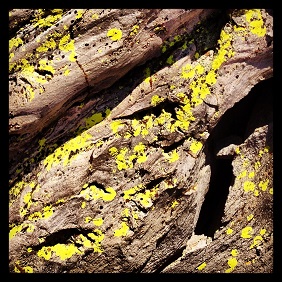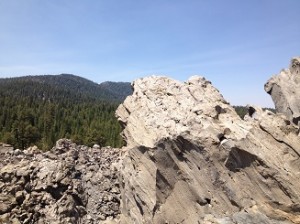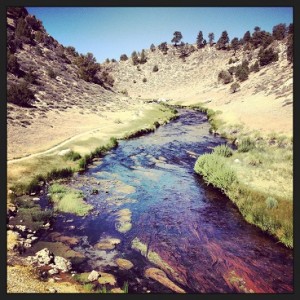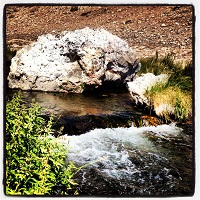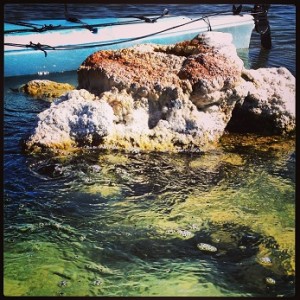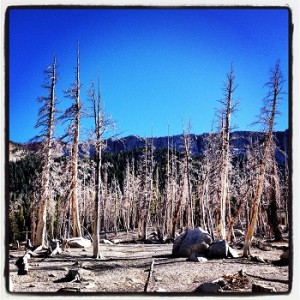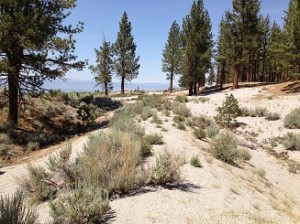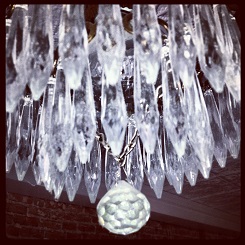If you want to touch, feel, see, smell and experience the geological forces that formed a large swath of California you must visit Mono and Inyo counties. I fell in love with the area bisected by Highway 395 years ago while traveling for work. On our latest excursion into the volcanic past of California we took a kayak trip across Mono Lake, hiked through the geological area of Hot Creek and climbed Obsidian Dome. Picture gallery and video recordings at the end of the post.
Volcanic treasures await around every corner
On a calm and cloudless day our Kayaks quietly glided across the alkaline waters of Mono Lake. The low water levels resulting from diversions to Southern California have exposed the grand tufa formations created by bubbling warm underground spring water. Tufa formation continues from the two springs flowing up and around tufa I passed by in the kayak.
The heavy water of Mono Lake

Salty Mono Lake water mixes with fresh water of Rush Creek for swirly effects.
Mono Lake is unusually clear as most algae and plants can’t tolerate the salty water at 9.6 pH. The primary aquatic life are the swarms of brine shrimp rising from the bottom in big clouds to the surface and the pupa stage of the local alkali flies. The water of Mono Lake has been described as soapy and oily. The alkaline water stripped my leather Teva sandals of all accumulated dirt and oil better than any washing I could give them.
Geochemistry in action
You can see the density of the Mono Lake water in swirly distortions as fresh water from the geothermal springs and Rush Creek flow in the heavier salt water. It looks something like a chemistry class experiment where two different liquids are combined. Mono Lake is geochemistry in action. The four hour kayak tour is tiring but an experience you’ll never forget.
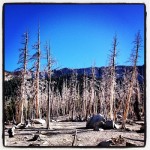
Conifer trees overcome by CO2 released by earthquakes next to Horseshoe Lake.
Subterranean climate change
We stayed in Mammoth Lakes which has its own rich geological history. A vestige of the most recent volcanic induced earthquake activity is up at Horseshoe Lake on the southern end of Mammoth Lakes. Earthquakes in the late 1980’s released captured CO2 which saturated the soil around the lake. This had the net effect of smothering the roots of the surrounding conifer trees. So great is the carbon dioxide you are cautioned not to spend too much time in low laying areas lest you are overcome by the high concentrations.
Hot Creek fumarole
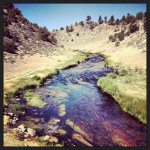
Hot Creek gorge in the Long Valley Caldera.
A short but beautiful hike will take you along Hot Creek east of Mammoth Lakes. Hot Creek cuts across the Long Valley Caldera until it empties into the Owens River. This area was once a great volcano that exploded years ago leaving a bowl. The eastern portion of Hot Creek is reminiscent of Bumpass Hell in Lassen with scalding hot geothermal springs of water. Unfortunately, the area has been fenced off so you can’t get too close to the geothermal activity. The sight of this fresh water creek creating a ribbon of green plants, slicing through volcanic rocks is a queer contrast to say the least. While the area is fairly remote along a gravel road, we saw numerous fly fishermen angling in the creek and long distant runners training in the area.
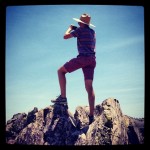
Walker, triumphant, after climbing Obsidian Dome.
Ascending Obsidian Dome
Our final side trip was to Obsidian Dome. We had no clue what to expect and were greeted with a huge bulge of volcanic rocks that had erupted through the earth’s surface. In retrospect, climbing up Obsidian Dome was not the safest activity. A contrast to the overly cautious Hot Creek Geologic Site, I saw no government signs extolling the virtue of caution. There are ample opportunities to fall, twist an ankle or actually get stuck if a large boulder decides to shift. This was a thrill seeking event we hadn’t anticipated.
Frozen rock and glass
Once on top, exploring this raw landscape is phenomenal. You are actually looking at igneous rock that was mixed, swirled and squeezed out of the ground. The most fascinating pieces to me were chunks of rock with alternating layers of gray pumice and the black glass of obsidian. The porous light weight pumice mixed with the dense shiny black obsidian.
History of mining and railroads
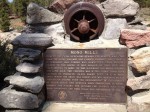
Mono Mills, Bodie Railroad and Lumber Company.
We took a little detour to find the historical monument of the Bodie Railway and Lumber Company southeast of Mono Lake. This railroad was built in 1881 to transport primarily wood to the booming, now ghost, town of Bodie. Vast quantities of wood were necessary to heat the steam engines operating at the mines, heating homes, constructing buildings and timber to shore up mine shafts. Bodie itself was a product of the volcanic activity. Magma and steam that rose up from the depths of the earth concentrated gold and silver underneath the hills of Bodie.
Too much for just one vacation trip
There is no lack of hikes and geological wonders to explore along Highway 395. Except for a few areas like Devil’s Postpiles, you’ll never really encounter any crowds. We still have a long list of items we want to hike to, climb over or swim in. I suspected many more vacation trips are in store back to the volcanic area of Mono and Inyo counties.
Click on thumbnail to enlarge image.



